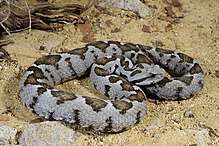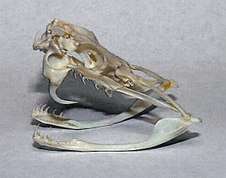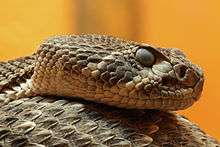Viperidae
| Viperidae | |
|---|---|
 | |
| Ottoman viper, Vipera xanthina | |
| Scientific classification | |
| Kingdom: | Animalia |
| Phylum: | Chordata |
| Class: | Reptilia |
| Order: | Squamata |
| Suborder: | Serpentes |
| Family: | Viperidae Oppel, 1811 |
| Synonyms | |
| |
The Viperidae (vipers) is a family of venomous snakes found in most parts of the world, excluding Antarctica, Australia, Hawaii, New Zealand, Madagascar, various other isolated islands, and north of the Arctic Circle. All have relatively long, hinged fangs that permit deep penetration and injection of snake venom. Four subfamilies are currently recognised.[2] They are also known as viperids. The name "viper" is derived from the Latin word vipera, -ae, also meaning viper, possibly from vivus ("living") and parere ("to beget"), referring to the trait viviparity (giving live birth) common in vipers but not in snakes at large.[3]
Description

All viperids have a pair of relatively long solenoglyphous (hollow) fangs that are used to inject venom from glands located towards the rear of the upper jaws, just behind the eyes. Each of the two fangs is at the front of the mouth on a short maxillary bone that can rotate back and forth. When not in use, the fangs fold back against the roof of the mouth and are enclosed in a membranous sheath. This rotating mechanism allows for very long fangs to be contained in a relatively small mouth. The left and right fangs can be rotated together or independently. During a strike, the mouth can open nearly 180° and the maxilla rotates forward, erecting the fangs as late as possible so that the fangs do not become damaged, as they are brittle. The jaws close upon impact and the muscular sheaths encapsulating the venom glands contract, injecting the venom as the fangs penetrate the target. This action is very fast; in defensive strikes, it will be more a stab than a bite. Viperids use this mechanism primarily for immobilization and digestion of prey. Pre-digestion occurs as the venom contains proteases which degrade tissues. Secondarily, it is used for self-defense, though in cases with nonprey, such as humans, they may give a dry bite (not inject any venom). A dry bite allows the snake to conserve their precious reserve of venom, because once it has been depleted, it takes time to replenish, leaving the snake vulnerable. In addition to being able to deliver dry bites, vipers can inject larger quantites of venom into larger prey targets, and smaller amounts into small prey. This causes the ideal amount of pre-digestion for the lowest amount of venom.
Almost all vipers have keeled scales, a stocky build with a short tail, and due to the location of the venom glands, a triangle-shaped head distinct from the neck. The great majority have vertically elliptical, or slit-shaped, pupils that can open wide to cover most of the eye or close almost completely, which helps them to see in a wide range of light levels. Typically, vipers are nocturnal and ambush their prey.
Compared to many other snakes, vipers often appear rather sluggish. Most are ovoviviparous, holding eggs inside their bodies, where they hatch inside and emerge living. However, a few lay eggs in nests. Typically, the number of young in a clutch remains constant, but as the weight of the mother increases, larger eggs are produced, yielding larger young.
Geographic range
Viperid snakes are found in the Americas, Africa, and Eurasia. In the Americas, they are native from south of the 48th parallel, through the United States, Mexico, Central America, and into South America. In the old world, viperids are located everywhere except Siberia, Ireland, and the continent of Australia. The adder, a viperid, is the only venomous snake found in Great Britain, and is also found north of the Arctic Circle in Norway and Sweden.[1]
Venom
Viperid venoms typically contain an abundance of protein-degrading enzymes, called proteases, that produce symptoms such as pain, strong local swelling and necrosis, blood loss from cardiovascular damage complicated by coagulopathy, and disruption of the blood-clotting system. Death is usually caused by collapse in blood pressure. This is in contrast to elapid venoms that generally contain neurotoxins that disable muscle contraction and cause paralysis. Death from elapid bites usually results from asphyxiation because the diaphragm can no longer contract. However, this rule does not always apply; some elapid bites include proteolytic symptoms typical of viperid bites, while some viperid bites produce neurotoxic symptoms.[4]
Proteolytic venom is also dual-purpose: firstly, it is used for defense and to immobilize prey, as with neurotoxic venoms; secondly, many of the venom's enzymes have a digestive function, breaking down molecules in prey items, such as lipids, nucleic acids, and proteins.[5] This is an important adaptation, as many vipers have inefficient digestive systems.[6]
Due to the nature of proteolytic venom, a viperid bite is often a very painful experience and should always be taken seriously, though it may not necessarily prove fatal. Even with prompt and proper treatment, a bite can still result in a permanent scar, and in the worst cases, the affected limb may even have to be amputated. A victim's fate is impossible to predict, as this depends on many factors, including the species and size of the snake involved, how much venom was injected (if any), and the size and condition of the patient before being bitten. Viper bite victims may also be allergic to the venom and/or the antivenom.
Behavior
These snakes can decide how much venom to inject depending on the circumstances. The most important determinant of venom expenditure is generally the size of the snake; larger specimens can deliver much more venom. The species is also important, since some are likely to inject more venom than others, may have more venom available, strike more accurately, or deliver a number of bites in a short time. In predatory bites, factors that influence the amount of venom injected include the size of the prey, the species of prey, and whether the prey item is held or released. The need to label prey for chemosensory relocation after a bite and release may also play a role. In defensive bites, the amount of venom injected may be determined by the size or species of the predator (or antagonist), as well as the assessed level of threat, although larger assailants and higher threat levels may not necessarily lead to larger amounts of venom being injected.[7]
Prey tracking

Hemotoxic venom takes more time than neurotoxic venom to immobilize prey, so viperid snakes need to track down prey animals after they have been bitten,[7] in a process known as "prey relocalization". Vipers are able to do this via certain proteins contained in their venom. This important adaptation allowed rattlesnakes to evolve the strike-and-release bite mechanism, which provided a huge benefit to snakes by minimizing contact with potentially dangerous prey animals.[8] However, this adaptation then requires the snake to track down the bitten animal to eat it, in an environment full of other animals of the same species. Western diamondback rattlesnakes (Crotalus atrox) respond more actively to mouse carcases that have been injected with crude rattlesnake venom. When the various components of the venom were separated out, the snakes responded to mice injected with two kinds of disintegrins. These disintegrin proteins are responsible for allowing the snakes to track down their prey.[8]
Subfamilies
| Subfamily[2] | Taxon author[2] | Genera[2] | Species[2] | Common name | Geographic range[1] |
|---|---|---|---|---|---|
| Azemiopinae | Liem, Marx & Rabb, 1971 | 1 | 1 | Fea's viper | Myanmar, southeastern Tibet across southern China (Fujian, Guangxi, Jiangxi, Kweichow, Sichuan, Yunnan, Zhejiang) to northern Vietnam |
| Crotalinae | Oppel, 1811 | 18 | 151 | Pit vipers | In the Old World from eastern Europe eastward through Asia to Japan, Taiwan, Indonesia, peninsular India and Sri Lanka; in the New World from southern Canada southward through Mexico and Central America to southern South America |
| Viperinae | Oppel, 1811 | 12 | 66 | True or pitless vipers | Europe, Asia, and Africa |
Type genus = Vipera—Laurenti, 1768[1]
Taxonomy
That family Viperidae is attributed to Oppel (1811), as opposed to Laurenti (1768) or Gray (1825), is subject to some interpretation. However, the consensus among leading experts is that Laurenti used viperae as the plural of vipera (Latin for "viper", "adder", or "snake") and did not intend for it to indicate a family group taxon. Rather, it is attributed to Oppel, based on his Viperini as a distinct family group name, despite the fact that Gray was the first to use the form Viperinae.[1]
See also
- List of snakes, overview of all snake families and genera
- Snakebite
References
- 1 2 3 4 5 McDiarmid RW, Campbell JA, Touré T. 1999. Snake Species of the World: A Taxonomic and Geographic Reference, vol. 1. Herpetologists' League. ISBN 1-893777-00-6 (series). ISBN 1-893777-01-4 (volume).
- 1 2 3 4 5 "Viperidae". Integrated Taxonomic Information System. Retrieved 10 August 2006.
- ↑ Gotch AF. 1986. Reptiles -- Their Latin Names Explained. Poole, UK: Blandford Press. 176 pp. ISBN 0-7137-1704-1.
- ↑ "Viperids". Snakesuntamed.webr.ly.
- ↑ Slowinski, Joe (2000). "Striking Beauties: Venomous Snakes". California Wild. 53:2. Archived from the original on 13 October 2004.
- ↑ Smith, SA (2004). "Did Someone Say... SSSSnakes?". Maryland Dept. of Natural Resources.
- 1 2 Hayes WK, Herbert SS, Rehling GC, Gennaro JF. 2002. Factors that influence venom expenditure in viperids and other snake species during predatory and defensive contexts. In Schuett GW, Höggren M, Douglas ME, Greene HW. 2002. Biology of the Vipers. Eagle Mountain Publishing, LC. 580 pp. 16 plates. ISBN 0-9720154-0-X.
- 1 2 Saviola, A.J.; Chiszar, D.; Busch, C.; Mackessy, S.P. (2013). "Molecular basis for prey relocation in viperid snakes". BMC Biology. 11. doi:10.1186/1741-7007-11-20.
Further reading
- Gray JE. 1825. A synopsis of the genera of reptiles and Amphibia, with a description of some new species. Annals of Philosophy, new ser., 10: 193–217.
- Laurenti JN. 1768. Specimen Medicum, Exhibens Synopsin Reptilium Emendatam cum Experimentis circa Venena et antidota reptilium Austriacorum. J.T. de Trattnern, Wien.
- Oppel M. 1811. Mémoire sur la classification des reptiles. Ordre II. Reptiles à écailles. Section II. Ophidiens. Annales du Musée National d'Histoire Naturelle, Paris 16: 254–295, 376–393.
External links
| Wikimedia Commons has media related to Viperidae. |
- Viperidae at the Reptarium.cz Reptile Database. Accessed 3 November 2008.


- Pit vipers